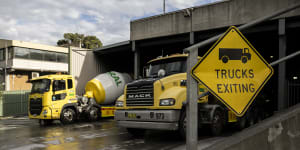Industrial developer Logos is working with Boral on a plan for 450 hectares of its 1105-hectare quarry in Deer Park in Melbourne’s north-west suburbs.

Boral has plans to develop its Deer Park quarry into an industrial estate.Louie Douvis
Unlike chemicals behemoth Orica,which sold its 66 hectare Deer Park site to UniSuper for $260 million last week,Boral will retain any future project and bank the income stream.
UniSuper is planning a $1 billion industrial project for its site,which is half of Orica’s surplus landholding on the Western Ring Road.
The super fund will undertake the development with GPT and HB+B Property and ultimately own the property,in a deal negotiated directly by Charter Keck Cramer.
It’s UniSuper’s second big industrial play in a year. Last July it paid around $560 million for half of the $1.1 billion Australian Industrial Partnership,giving it a stake in 20 assets,12 in Sydney’s Quarry Industrial Estate and the remainder in Truganina in Melbourne’s west.
Institutions and super funds are desperately trying to offset falling office tower values with investments in industrial property which have largely held their ground,especially as changes to the way people shop increases the need for warehousing closer to cities.
But there are signs of a slowdown,partly due to the constrained supply of land and partly because higher interest rates have stalled expansion plans.
Colliers agent Nick Saunders said the lack of land in Sydney underpins the property plays in Melbourne and Brisbane,with the country’s big logistics providers likely to opt for larger facilities in the cheaper cities but retain smaller warehouses in pricey Sydney.
According to research from CBRE,the industrial vacancy rate in Sydney is 0.71 per cent and 1.6 per cent in Melbourne. Half of Melbourne’s take-up last year was in the west,which will also account for the 60 per cent of the 1.6 million square metres of new supply coming in the next few years.
The move by big landholders to unlock properties on the CBD fringe could change the current equation and freeze out institutional investors.
Boral boss Vik Bansal told investors at its earnings presentation earlier this month that the “underlying driver and purpose is to ideally create a long-term recurring earnings stream for Boral.”
“When it is confirmed that a site is surplus to our operations,the team shifts focus to repurposing the asset” Bansal said.
Saunders,who is selling a North Laverton property for agrichemicals firm Nufarm,said rising online retail sales is driving many of the changes.
“With online sales trends on the rise,the industrial estate provides a solution for e-commerce businesses. It fulfils consumers’ online shopping needs – from delivery to a retailer,or to a purchaser’s home,” Saunders said.
While the Orica deal puts the price of large land plots in Melbourne’s west at just under $400 a sq m,smaller lots are fetching more $600 a sq m.
Records show US supermarket giant Costco paid $33.37 million to Powercor in August last year for a five-hectare site on Ballarat Road,Ardeer.
Costco turned the first sod on its new $62 million 15,000 sq m supermarket and petrol station last week. That price suggests Nufarm might achieve a similar result for a site it’s selling at 16-18 Hume Road.
The Business Briefing newsletter delivers major stories,exclusive coverage and expert opinion..